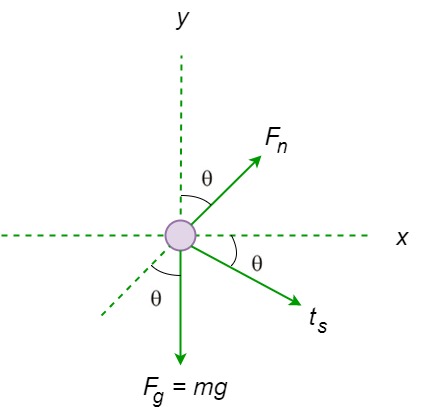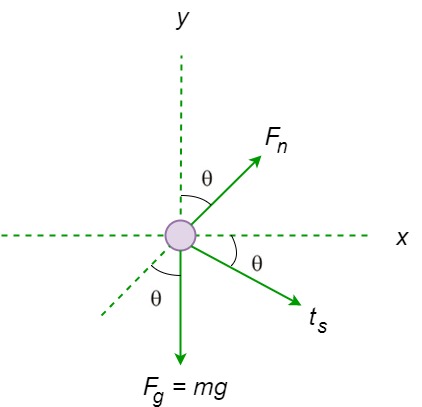
Concept explainers
(a)
To Find:The normal force.
(a)
Answer to Problem 95P
Explanation of Solution
Given Information:
Mass of the car
Angle of incline,
Radius of curvature,
Speed of car is
Formula Used:
Newton’s second law of motion:
Calculation:
The free body diagram shows the forces acting the car.

Speed of the car
Apply
Apply
Multiply the equation
Add the equation
Solving the above equation for
Substitute all the known values in equation
Conclusion:
Therefore, the normal force is
(b)
To Find:The frictional force exerted.
(b)
Answer to Problem 95P
Explanation of Solution
Given Information:
The speed of car on the curve road is
Formula Used:
Newton’s second law of motion:
Calculation:
The free body diagram shows the forces acting the car.

Apply
Solving the equation
Calculation:
Therefore, the frictional force is
Here the negative sign indicates that force
Want to see more full solutions like this?
Chapter 5 Solutions
Physics for Scientists and Engineers
- The 1.5Mg 4-wheel drive jeep is used to push two identical packages, each weighing 500Kg. If the coefficient of static friction between the tires and the ground is 0.6, determine the fastest possible speed that the jeep can reach in 5s, without the tires spinning. The coefficient of kinetic friction between the packages and the ground is 0.3.arrow_forwardCircular turns of radius r in a race track are often banked at an angle θ to allow the cars to achieve higher speeds around the turns. Assume friction is not present, and use the coordinate system specified. Part (a) Find the y-component of the normal force FN on a car going around the turn in terms of the angle θ and the magnitude of the normal vector FN. Part (b) Find the x-component of the normal force FN on a car going around the turn in terms of the angle θ and the magnitude of the normal vector FN. Part (c) Now write the magnitude of the normal force in terms of the force of gravity Fg and the angle θ. Part (d) Now write the magnitude of the normal force again, this time in terms of the gravitational force Fg, g, θ, the radius of the track r, and the velocity that the car is traveling at v. Part (e) Now assume that the car is moving at 15 m/s and the radius of the track is 410 m. What is the angle θ in degrees?arrow_forwardA fluid‑like substance called synovial fluid lubricates the surfaces where bones meet in joints, making the coefficient of static friction between bones very small. For simplicity, assume the surfaces in the knee are flat and horizontal. Why is the minimum force required for initiating movement of bones in a typical knee joint different for different people, in spite of the fact that their joints have the same coefficient of static friction?arrow_forward
- A 45 kg box is at rest at one end of a 2 meter board. That end of the board is slowly raised at an incline until the box starts to slide. At that point, the angle is at 34 degrees. The coefficient of kinetic friction is 0.50N. Please help me calculate the coefficient of static friction between both the box and the board?arrow_forwardThe distance between two telephone poles is d = 54.0 m. When a 1.20 kg bird lands on the telephone wire midway between the poles, the wire sags h = 0.206 m. (a) Draw a free-body diagram of the midpoint of the wire (where the bird is perched). mg O X* (b) How much tension (in N) does the bird produce in the wire? Ignore the weight of the wire. 3.15 Your response differs significantly from the correct answer. Rework your solution from the beginning and check each step carefully. N Need Help? Read Itarrow_forwardA police officer in hot pursuit drives her car through a circular turn of radius 300 m with a constant speed of 80.0 km/h. Her mass is 55.0 kg.What are (a) the magnitude and (b) the angle (relative to vertical) of the net force of the officer on the car seat? (Hint: Consider both horizontal and vertical forces.)arrow_forward
- Consider two blocks that are resting on top of each other. The lower block has mass m2 = 4.8 kg and is resting on a frictionless table. The upper block has a mass of m = 2.2 kg. Suppose the coefficient of static friction between the two blocks is given by µe 0.50. A force of magnitude Fis applied as shown for which it is the maximum pushing force applied horizontally to the upper block so that the two blocks move together without slipping. F frictionless Motion m2 (a) Draw the free body diagram of the two blocks. (b) What is the friction force between the two blocks? (Ans: 10.79 N) (c) What is the acceleration of these two blocks? (Ans: 2.25 m/s?) (d) What is the maximum pushing torce, F? (Ans: 15.74 N)arrow_forwardGiven the following three body system. The coefficient of static friction between the two masses is 0.50. The coefficient of kinetic friction between m2 and the plane is 0.20. Theta is 200. Find the largest value of m3 if m1 doesn’t slip on m2. m1 = 5kg, m2 = 10kg.arrow_forward12. A 3.00-kg block starts from rest at the top of a 30.0° incline and slides a distance of 2.00 m down the incline in 1.50 s. Find (a) the magnitude of the acceleration of the block, (b) the coefficient of kinetic friction between block and plane, (c) the friction force acting on the block, and (d) the speed of the block after it has slid 2.00 m. Answers: a) 1.78 m/s² b) 0.368 c) 9.37 N d) 2.67 m/sarrow_forward
- Consider two blocks that are resting on top of each other. The lower block has mass m2 = 4.8 kg and is resting on a frictionless table. The upper block has a mass of m = 2.2 kg. Suppose the coefficient of static friction between the two blocks is given by µe 0.50. A force of magnitude Fis applied as shown for which it is the maximum pushing force applied horizontally to the upper block so that the two blocks move together without slipping. F m 1 frictionless Motion m 2arrow_forwardAn acrobat standing on the lateral surface of a cylinder moves his legs and moves the cylinder with constant speed. The cylinder is on a rough (frictional) horizontal surface. If the coefficient of friction between the shoes and the cylinder is mu = 0.21 Determine the friction force between the cylinder and the stuntman. The mass of the stuntman is m=65 Kg.arrow_forwardAs shown a worker poling a boat—a very efficient mode of transportation—across a shallow lake. He pushes parallel to the length of the light pole, exerting a force of magnitude 240 N on the bottom of the lake.Assume the pole lies in the vertical plane containing the keel of the boat. At one moment, the pole makes an angle of 35.0° with the vertical and the water exerts a horizontal drag force of 47.5 N on the boat, opposite to its forward velocity of magnitude 0.857 m/s. The mass of the boat including its cargo and the worker is 370 kg.(a) The water exerts a buoyant force vertically upward on the boat. Find the magnitude of this force. (b) Model the forces as constant over a short interval of time to find the velocity of the boat 0.450 s after the moment described.arrow_forward
 Principles of Physics: A Calculus-Based TextPhysicsISBN:9781133104261Author:Raymond A. Serway, John W. JewettPublisher:Cengage Learning
Principles of Physics: A Calculus-Based TextPhysicsISBN:9781133104261Author:Raymond A. Serway, John W. JewettPublisher:Cengage Learning
